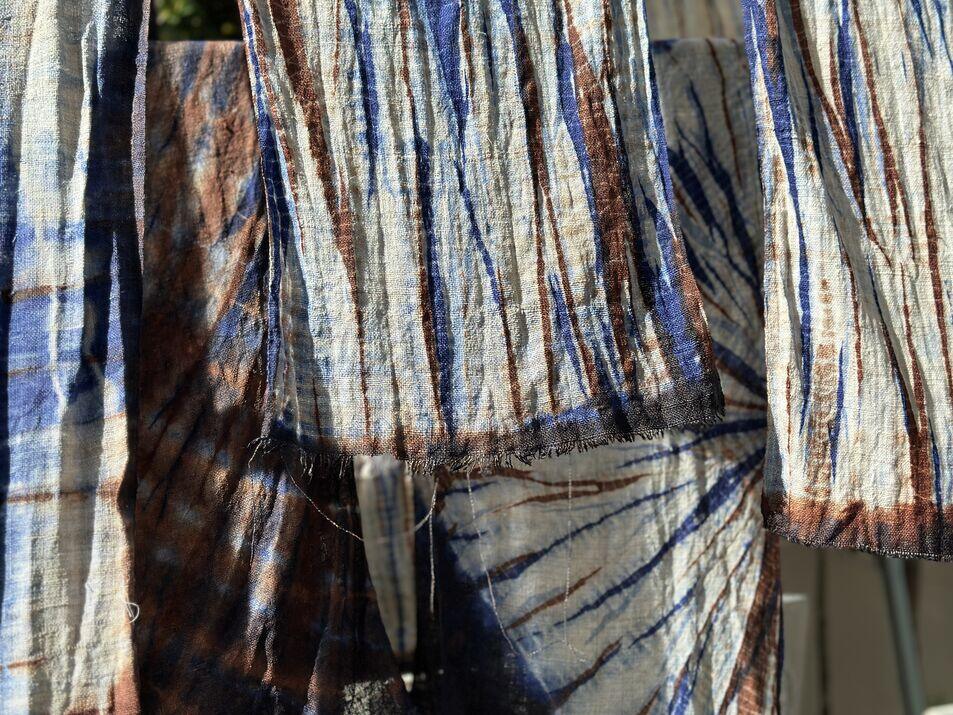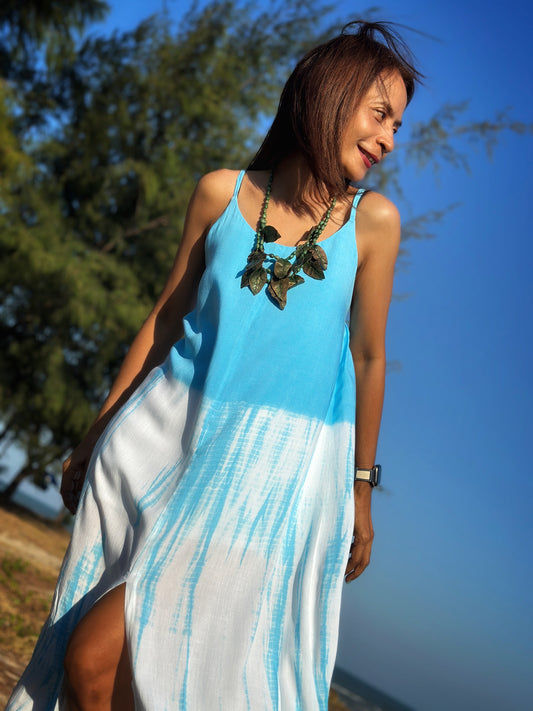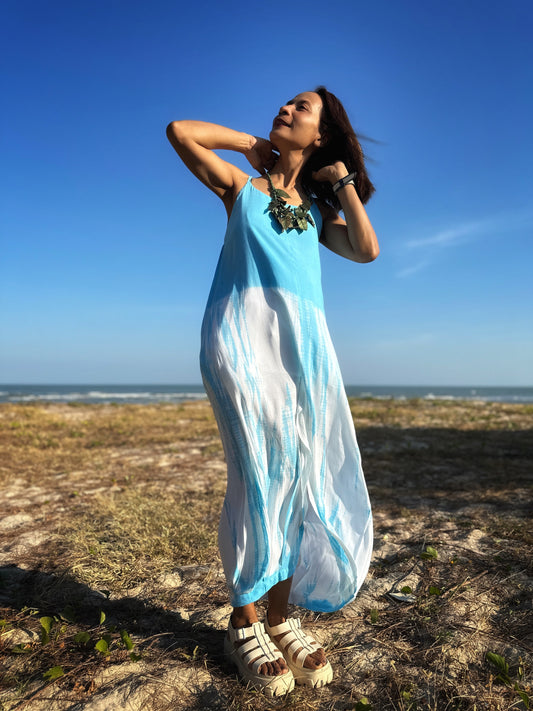
Shibori : The Art of Japanese Tie Dyeing
Share
Shibori is a traditional Japanese technique for dyeing fabric that creates some amazing works of art. This ancient craft uses a variety of techniques, including binding, folding and twisting fabric to create detailed patterns.
Shibori is a unique blend of artistry and tradition, which sets it apart from traditional tie-dye. Each piece is truly one-of-a-kind.
We'll explore the world of shibori, looking at its rich history, the different techniques that make it special, and its cultural meaning.
From the lovely knots of kanoko shibori to the lively waves of arashi shibori. Each method is a testament to creativity and craftsmanship.
Table of contents :
- Understanding Shibori
- History of Shibori
- Techniques Used in Shibori
- Cultural Significance of Shibori
- Shibori FAQ's
- Conclusion
- Shibori and Nuichan
Understanding Shibori
What is Shibori
Shibori is a Japanese term that covers a range of resist-dyeing techniques used to create unique patterns on fabric. The word itself comes from "shiboru," meaning "to wring" or "to squeeze" [1].
The process involves manipulating the fabric in various ways such as binding, folding, stitching, and twisting. Once the desired pattern has been applied, the fabric is typically dyed with indigo.
This technique allows certain areas of the fabric to remain undyed, making stunning contrasts and designs.

History of Shibori
It all started in Kyoto with the Kanoko Shibori method, known for its intricate designs crafted from high-quality silk. Although this method was highly sought after, it often came with a hefty price tag, making it less accessible to the average person.[2]
However, as cotton production surged and indigo dyeing gained popularity, various regions began to adopt these techniques.One notable area is Arimatsu-Narumi, located in what’s now Nagoya City.
During the Edo period, which spanned from the early 17th to the mid-19th century, dyeing techniques flourished, leading to the birth of Arimatsu shibori.
This lightweight cotton fabric became incredibly popular for making yukatas, and the region quickly emerged as a hotspot for tie-dye production.[3]
What sets Arimatsu shibori apart is its impressive variety—over 100 different patterns!
Because of this uniqueness, it was officially recognised as a national traditional craft in 1975, earning the name "Arimatsu-Narumi shibori."

Image provided by the Arimatsu Shibori Commerce and Industry Cooperative Association, donated by Kishino Yoriko
Techniques Used in Shibori :
-
Kanoko Shibori - The Bound Resist Technique:
This popular method involves binding sections of fabric with rubber bands or string to create distinct patterns. The tightness of the binding and the grouping of the sections determine the final design. Beautiful circular motifs are the result and they can vary in size and complexity.[4]
-
Arashi Shibori - The Pole-Wrapping Technique:
In this technique, fabric is wrapped around a pole and bound with twine. The patterns often resemble diagonal or wavy lines, similar to of stormy seas. This dynamic style captures movement and energy in the fabric.[4]
-
Itajime Shibori - Fold and Clamp Technique:
This method wedges fabric between two wooden boards, clamping it tightly to resist dye penetration. The folds create striking geometric patterns that are visually captivating. Itajime shibori is known for its precision and symmetry, making it a favourite among textile artists.[4]
-
Kumo Shibori - Spider Web Technique:
This technique involves pleating and pinching the fabric to create a spider web-like appearance. Often using rubber bands for binding, kumo shibori produces intricate designs that bring natural forms and textures to mind.[4]

-
Nui Shibori - The Stitch-Resist Technique:
Similar to kanoko shibori but using basting stitches for binding instead of rubber bands, nui shibori allows for more intricate designs. The stitching creates a delicate texture that enhances the visual appeal of the finished piece.[4]

Cultural Significance of Shibori
Shibori has deep roots in Japanese culture, dating back several centuries. Originally used for practical purposes such as creating durable textiles for clothing and household items, shibori has evolved into an art form celebrated for its beauty and craftsmanship.
The artistry involved in creating shibori textiles requires patience and skill. Each piece is unique due to the manual processes involved in shaping the fabric before dyeing. This talent not only reflects individual creativity but also connects artisans to their cultural heritage.
Shibori is more than just a dyeing technique; it represents a philosophy of treating cloth as a three-dimensional object rather than a flat surface. This method aligns with classic Japanese aesthetics, which appreciate the charm of imperfection and the beauty of the natural world.
Shibori FAQ's
- What is Shibori?
Shibori is a traditional Japanese manual resist dyeing technique that involves various methods like binding, stitching, folding, twisting, or compressing fabric to create patterns before dyeing. This process results in unique, intricate designs that are characteristic of Shibori art.
- What makes Shibori different from other tie-dye techniques?
Shibori stands out due to its Japanese origin and the diversity of methods used for resist dyeing, which include binding, stitching, folding, twisting, or compressing the fabric. These techniques often produce more intricate and varied patterns compared to the typical tie-dye methods which mainly involve simple tying.
- Can Shibori be applied to any type of fabric?
While Shibori can be applied to various fabrics, cotton and silk are traditionally favored because they absorb dye well and can hold the complex patterns created by Shibori techniques effectively. These materials are known for their excellent dye uptake and texture that complements the Shibori designs.
- How long does it take to create a Shibori design?
The creation time for a Shibori design varies with the complexity of the pattern and the technique used. Simple designs might take a few hours, but more detailed and intricate patterns can take several days from the initial preparation to the final dyeing process.
- Are there different styles of Shibori, and which ones are commonly used?
Yes, there are many styles of Shibori, including Kanoko (tie-dye), Kumo (spiderweb), Arashi (pole-wrapping), and more. Kanoko is popular for its detailed, small-scale patterns, while Kumo is favored for its bold, radiating designs. These styles are commonly used in fashion for their distinct visual impact and the variety they bring to textile design.
- Is Shibori dyeing environmentally friendly?
Traditional Shibori dyeing can be environmentally friendly, especially when natural dyes are used. However, the environmental impact depends on the choice of dyes and water usage. Modern practices often aim to use sustainable methods to minimize ecological footprints.
- What care should be taken when washing Shibori garments?
Shibori garments should be washed with care, ideally by hand in cold water, to maintain the vibrancy of the colors and the integrity of the patterns. It's recommended to avoid harsh detergents and to dry them out of direct sunlight to prevent fading.
- How do Shibori patterns relate to Japanese culture?
Shibori patterns are deeply embedded in Japanese culture, often reflecting elements of nature, seasonal changes, or traditional motifs. Each design can carry symbolic meanings, such as wishes for prosperity, health, or beauty, connecting the art to centuries of cultural heritage.
- What are some modern interpretations of Shibori in fashion?
In contemporary fashion, Shibori has been embraced for its unique aesthetic. Designers incorporate Shibori into modern clothing by blending traditional techniques with current fashion trends, creating pieces that range from casual wear to high-end fashion, often highlighting the contrast between traditional craftsmanship and modern design.
Conclusion
Shibori is a charming art that blends detailed methods with deep cultural meaning.
Whether you’re looking to explore new techniques or simply someone who appreciates fabrics, shibori invites you to discover its timeless charm.
With the rise of sustainable fashion, shibori stands out as a perfect mix of tradition and modern style. It’s a great choice for anyone looking for beautiful textiles that celebrate craftsmanship and heritage.

Shibori and Nuichan
At Nuichan, we're excited to share our stunning collection of Shibori designs, each piece reflecting the rich artistry and tradition of this beautiful Japanese dyeing technique.
Our journey into Shibori began with personal training at the home of Shibori in Arimatsu, Japan. Here we learned the intricate methods that make each item truly unique.
With a focus on comfort and style, our Shibori dresses inspire confidence and creativity in every outfit. Whether you're dressing up for a special occasion or keeping it casual, our collection offers something for everyone.
We believe in making sustainable fashion fun and accessible, empowering you to express your unique style while honouring craftsmanship and heritage.
Shop with us knowing you're getting high-quality, one-of-a-kind items that not only look great but also support sustainable practices.
Have fun exploring our Shibori collection!
| ⭐⭐⭐⭐⭐ | ⭐⭐⭐⭐⭐ | ⭐⭐⭐⭐⭐ |
|---|---|---|
|
"Absolutely love my shibori dress. Beautiful quality, unique. Can't wait to order more." — Judith |
"As always perfect, it's my 6th or 7th dress from Nuichan and I love them all. Gorgeous material, colors, beautifully made and super fast shipping." — Marianna |
"What a gorgeous shade of blue! The dress is beautiful and the style is unique and fun. A great summer addition to my wardrobe. Fast delivery, great seller. Thank you!" — Dana |
Sources:
[1] https://fashionthefuturenow.org/2019/05/28/shibori/
[2] https://www.zen-hd.co.jp/zen_club/?p=8577
[3] https://story.nakagawa-masashichi.jp/craft_post/121392
[4] https://www.seamwork.com/articles/shibori-dyeing








